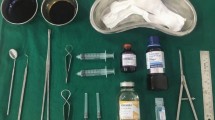Abstract
Introduction
Hypermobility disorders of the Temporomandibular joint (TMJ) can be treated by both conservative and surgical approaches. Conservative approaches should be considered as first line treatment for such disorders. Prolotherapy with 25 % dextrose being injected into the posterior pericapsular tissues is one such treatment modality with favorable outcomes.
Aim
To study the efficacy of single injection of 25 % dextrose in pericapsular tissues in the management of hypermobility joint disorders of TMJ as first line treatment.
Patients and Methods
We have studied a total of 23 patients suffering from either chronic recurrent dislocation or subluxation of the TMJ who were treated with the single injection technique prolotherapy with 25 % dextrose into the pericapsular tissues along with auriculotemporal nerve block and found encouraging results.
Results
Overall success rate in our study was 91.3 % (21/23) with a minimum follow up period of 13.9 months. Number of successfully treated patients requiring one injection was 7 (30.4 %), two injections was 8 (34.7 %) and requiring three injections was 6 (26.1 %). There were no permanent complications.
Conclusion
Hence the use of 25 % dextrose as a proliferant to treat hypermobilty disorders of the TMJ is recommended by us as a first line treatment option as it is safe, economical and an easy procedure associated with minimal morbidity.




Similar content being viewed by others
References
Quinn PD (1998) Osseous surgery of the temporomandibular joint. In: Quinn PD (ed) Color atlas of temporomandibular joint surgery. Mosby, St. Louis, pp 102–111
Adekeye EO, Shamia RI, Cove P (1976) Inverted L-shaped ramus osteotomy for prolonged bilateral dislocation of the temporomandibular joint. Oral Surg Oral Med Oral Pathol 41:568–577
August M, Troulis MJ, Kaban LB (2004) Hypomobility and hypermobility dis-orders of the temporomandibular joint. In: Miloro M, Ghali GE, Larsen PE et al (eds) Peterson’s principles of oral and maxillofacial surgery. BC Decker, London, pp 1033–1047
Sato J, Segami N, Nishimura M et al (2003) Clinical evaluation of arthroscopic eminoplasty for habitual dislocation of the temporomandibular joint: comparative study with conventional open eminectomy. Oral Surg Oral Med Oral Pathol Oral Radiol Endodontol 95:390
Aaron L, Daniel P (2015) Temporomanibular joint dislocation. Oral Maxillofacial Surg Clin Am 27:125–136
Banks A (2003) A rationale for prolotherapy. J Orthop Med J 116:1179
Refai H, Altahhan O, Elsharkawy R (2011) The efficacy of dextrose prolotherapy for temporomandibular joint hypermobility: a preliminary prospective, randomized, double-blind, placebo-controlled clinical trial. J Oral Maxillofac Surg 69(2962–70):9
Zhou H, Hu K, Ding Y (2014) Modified dextrose prolotherapy for recurrent temporomandibular joint dislocation. Br J Oral Maxillofac Surg 52:62–66
Coser R, da Silveira H, Medeiros P, Ritto FG (2015) Autologous blood injection for the treatment of recurrent mandibular dislocation. Int J Oral Maxillofac Surg 44:1034–1037
Brachmann F (1964) Autologous blood injection for recurrent hypermobility of the temporomandibular joint. Dtsch Zahnarztl Z 15:97–102
Matsushita K, Abe T, Fujiwara T (2007) OK-432 (Picibanil) sclerotherapy for recurrent dislocation of the temporomandibular joint in elderly edentulous patients: case reports. Br J Oral Maxillofac Surg 45:511–513
Fu K, Chen HM, Sun ZP et al (2010) Long term efficacy of botulinum toxin type A for the treatment of habitual dislocation of the temporomandibular joint. Br J Oral Maxillofac Surg 48:281–284
Hegab AF (2013) Treatment of chronic recurrent dislocation of the temporomandibular joint with injection of autologous blood alone, intermaxillary fixation alone, or both together: a prospective, randomised, controlled clinical trial. Br J Oral Maxillofac Surg 51:813–817
Bradley P (2009) Injuries of the condylar and coronoid process. In: Rowe NL, Williams JL (eds) Maxillofacial injuries, vol 1. Elsevier, Churchill Livingstone, pp 354–355
Schultz LW (1937) A treatment of subluxation of the temporomandibular joint. JAMA 25:1035–1037
Hackett GS, Henderson DG (1955) Joint stabilization: an experimental, histologic study with comments on the clinical application in ligament proliferation. Am J Surg 80:968–973
Author information
Authors and Affiliations
Corresponding author
Ethics declarations
Conflict of interest
None.
Ethical Approval
All procedures performed in studies involving human participants were in accordance with the ethical standards of the institutional and/or national research committee and with the 1964 Helsinki declaration and its later amendments or comparable ethical standards.
Informed Consent
Informed consent was obtained from all individual participants included in the study.
Rights and permissions
About this article
Cite this article
Majumdar, S.K., Krishna, S., Chatterjee, A. et al. Single Injection Technique Prolotherapy for Hypermobility Disorders of TMJ Using 25 % Dextrose: A Clinical Study. J. Maxillofac. Oral Surg. 16, 226–230 (2017). https://doi.org/10.1007/s12663-016-0944-0
Received:
Accepted:
Published:
Issue Date:
DOI: https://doi.org/10.1007/s12663-016-0944-0




